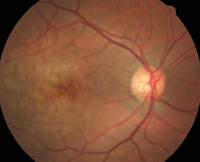 A 65-year-old white female presented for a routine eye examination. She had no visual complaints. Her ocular history was unremarkable. Her systemic history was significant for a stroke, which occurred two years earlier. She reported taking no medications, with the exception of a “baby aspirin” every day.
A 65-year-old white female presented for a routine eye examination. She had no visual complaints. Her ocular history was unremarkable. Her systemic history was significant for a stroke, which occurred two years earlier. She reported taking no medications, with the exception of a “baby aspirin” every day.
Her best-corrected visual acuity measured 20/20 OU. All preliminary testing was within normal limits. The slit lamp examination uncovered no anterior segment pathology. A dilated fundus examination revealed moderate-stage age-related macular degeneration (AMD), which was associated with both pigmentary changes and large areas of confluent soft drusen located throughout the macula OU. We uncovered no evidence of a choroidal neovascular membrane.
So, what recommendations should you make to this patient’s primary care physician (PCP), considering her medical history, current medication use and recent ocular diagnosis?
Risk Factors
AMD is the leading cause of blindness in elderly Americans.1 Advanced AMD, which is typically associated with visual impairment, is observed in roughly 10% of all cases.1 Although extensive research has been devoted to the understanding of the condition, its pathogenesis has not been completely elucidated. The cause of AMD likely is associated with a multitude of factors. Its prevalence and progression has been associated with cardiovascular disease, age, inflammation, gender, ethnicity, smoking, genetics, obesity, UV exposure and aspirin use.1-6
Aspirin Use and AMD
Two recent studies indicated that prolonged aspirin use was associated with an increased incidence of wet AMD.2,6 The first study—published by Barbara Klein, MD, MPH, and associates in December 2012—used participants from the Beaver Dam Eye Study.2 This was a longitudinal, population-based analysis of age-related eye diseases. It included 4,926 participants at baseline, who were evaluated every five years during a 20-year follow-up period.
One study subset evaluated patients who used aspirin at least twice a week. The researchers took retinal photographs, which were graded for the presence and severity of AMD.

Our patient’s right eye exhibited signs of moderate AMD. Should she avoid aspirin use?
After 15 years, 512 cases of early AMD and 117 cases of wet AMD were documented.2 The researchers noted a statistically significant correlation between aspirin use and of the incidence of wet AMD.2 Specifically, 1.76% of individuals who used aspirin regularly for 10 years developed wet AMD compared to 1.03% of non-users.2 No correlation was documented between long-term aspirin use and an increased incidence of early AMD. Further, the researchers noted that the amount of aspirin taken had no impact upon overall AMD incidence.2
The second study was authored by Gerald Liew, PhD, and associates in January 2013.6 Like the aforementioned study, Dr. Liew’s group determined that prolonged aspirin use was associated with the development of wet AMD.6
This prospective analysis evaluated an Australian cohort comprised of nearly 3,000 participants. Approximately 10% of the participants used aspirin regularly. Baseline retinal photographs were taken and graded to screen for the presence and/or stage of AMD.
After 15 years, 24% of the participants developed wet AMD.6 When adjusted for age, body mass index and existing cardiovascular complications, the researchers determined that aspirin users were 2.5 times more likely to develop wet AMD than non-users. More specifically, the incidence of wet AMD among non-regular aspirin users was 0.8% at five-year follow-up, 1.6% at 10 years and 3.7% at 15 years.6
On the other hand, the incidence of wet AMD among aspirin users was 1.9% at five-year follow-up, 7% at 10 years and 9.3% at 15 years.6 This suggests that the risk for wet AMD with regular aspirin use might be contingent upon the cumulative dosage. It is worth noting that the researchers did not uncover an association between aspirin use and an increased incidence of geographic atrophy.6
Study Inconsistencies
Aspirin is one of the most commonly used drugs today. In fact, one in five adults use aspirin on a regular basis.10 Moreover, nearly half of elderly Americans take aspirin every day.10
Aspirin
is used to relieve pain, reduce fever and treat inflammatory
conditions, such as rheumatoid arthritis. Further, it suppresses
clotting actions, which is why physicians often recommend aspirin as a
preventive treatment for myocardial infarction and stroke.
Several
adverse effects have been reported in patients who use aspirin
regularly, including allergies, bleeding and stomach ulcer.10
And, because aspirin reduces blood viscosity, it should not be used
prior to surgery or in conjunction with anticoagulants, such as
warfarin.
While Dr. Klein’s study revealed a statistically significant association between aspirin use and wet AMD, the incidence was relatively low.2 Because advanced AMD is somewhat rare, the increased incidence translates into a negligible overall risk. Additionally, the study did not review exact cause and effect. AMD is a multi-factorial disease associated with numerous risk factors—and yet, not all confounding risk factors were assessed.
A Note on Aspirin Use
A review of the literature suggests that the association between aspirin use and wet AMD is rather inconsistent. In fact, multiple reports have cited no significant association.4,5,7 One study published in 2009 concluded that a 10-year history of regular aspirin use (100mg every other day) was not associated with an increased risk of wet AMD.8 Even more interesting, another study indicated that combination aspirin and statin use actually protected individuals with early AMD from progressing to more advanced stages.9
As for Our Patient…
Despite mixed reports regarding aspirin use and the risk of wet AMD, we decided to send a summary letter to the patient’s PCP about our findings. The patient is being closely monitored for any macular changes or disease progression, and was asked to return to our clinic for further baseline testing.
At this time, we believe that there is insufficient evidence to change the current clinical practice when managing AMD patients who have a history of cardiovascular disease or stroke. Instead, AMD patients on aspirin therapy should be evaluated closely and actively comanaged with their PCPs.
1. Friedman DS, O’Colmain BJ, Muñoz B, et al. Prevalence of age-related macular degeneration in the United States. Arch Ophthalmol. 2004 Apr;122(4):564-72.
2. Klein BE, Howard KP, Gangnon RE, et al. Long-term use of aspirin and age-related macular degeneration. JAMA. 2012 Dec 19;308(23):2469-78.
3. de Jong PT. Aspirin and age-related macular degeneration. Ophthalmology. 2010 Jun;117(6):1279-80.
4. Clemons TE, Milton RC, Klein R, et al. Risk factors for the incidence of advanced age-related macular degeneration in the Age-Related Eye Disease Study (AREDS): AREDS report no. 19. Ophthalmology. 2005 Apr;112(4):533-9.
5. van Leeuwen R. Is medication use associated with the incidence of early age-related maculopathy? Pooled findings from 3 continents. Ophthalmology. 2004 Jun;111(6):1169-75.
6. Liew G, Mitchell P, Wong TY, et al. The association of aspirin use with age-related macular degeneration. JAMA Intern Med. 2013 Jan 21:1-7.
7. Christen WG. Glynn RJ, Ajani A, et al. Age-related maculopathy in a randomized trial of low-dose aspirin among US physicians. Arch Ophthalmol. 2001 Aug;119(8):1143-9.
8. Christen WG, Glynn RJ, Chew EY, et al. Low-dose aspirin and medical record-confirmed age-related macular degeneration in a randomized trial of women. Ophthalmology. 2009 Dec;116(12):2386-92.
9. Wilson HL, Schwartz DM, Bhatt HR, et al. Statin and aspirin therapy are associated with decreased rates of choroidal neovascularization among patients with age-related macular degeneration. Am J Ophthalmol. 2004 Apr;137(4):615-24.
10. Soni A. Agency for Healthcare Research and Quality. Aspirin use among the adult US noninstitutionalized population, with and without indicators of heart disease, 2005. Statistical Brief #179. Available at:
http://meps.ahrq.gov/mepsweb/data_files/publications/st179/stat179.pdf. Accessed February 10, 2013.

